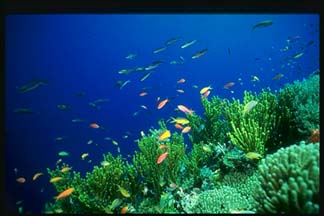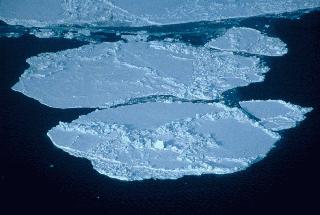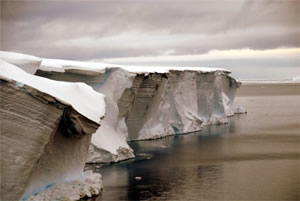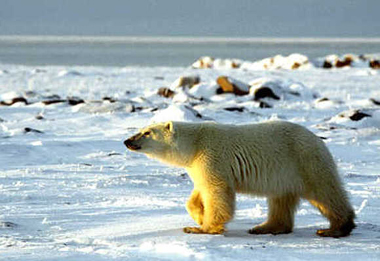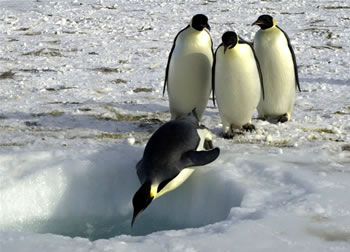Arctic Marine Life
For marine life, the Arctic Ocean is a unique place to live. It is the coldest ocean on Earth and is often capped with sea ice. During the coldest winter months there is little or no sunshine penetrating the water. During the summer months, the sun shines up to 24 hours a day.
Animals that can survive in the Arctic Ocean are adapted for this extreme environment. Some have a special substance within their bodies that prevents their blood from freezing. Others are covered with think layers of fat and fur to keep them warm. Take a look at some of the creatures that survive in the Arctic Ocean below.
Diatoms (algae) |
|
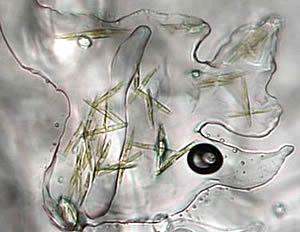 |
Single-celled algae called diatoms (from the Kingdom Protista) live within the Arctic sea ice. These ice diatoms are an important part of the Arctic marine food web. They make their energy by photosynthesis. (NOAA) |
 |
Do you see the orange band in the ice core? The orange ice is filled with diatoms. The diatoms live in the pore spaces between ice crystals and in salty brine water that is within the ice. Some zooplankton in the ocean water are able to eat diatoms from the bottom of the ice. (NOAA) |
Zooplankton (small floating animals) |
|
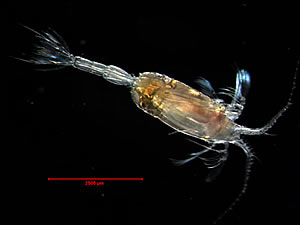 |
This copepod is a small crustacean, a relative of larger lobsters and shrimp. Copepods like this one float in the Arctic Ocean, moving there the water currents take them. Animals that move where the water takes them and are unable to swim somewhere else are called zooplankton.Copepods have a hard shell on the outside of their bodies called an exoskeliton. Zooplankton are an important food for fish in the Arctic Ocean. (Russ Hopcroft/UAF/CoML/NOAA) |
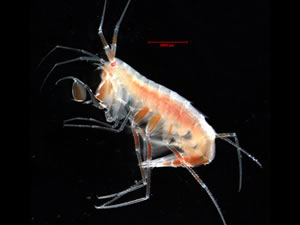 |
Amphipods are also small crustaceans. Amphipods have a hard shell on the outside of their bodies called an exoskeliton. (Russ Hopcroft/UAF/CoML/NOAA) |
Fish |
|
 |
Arctic cod eat zooplankton like copepods, and are eaten by marine mammals like seals.(Russ Hopcroft/UAF/CoML/NOAA) |
 |
This image of a pink fish was taken by a remotely operated underwater vehicle (called an ROV) at the bottom of the Arctic Ocean. This photo was passed along to scientists at the Smithsonian Institution so that they could identify the fish species. (NOAA) |
Marine Mammals |
|
 |
Walruses in the Arctic spend about half their lives in the chilly ocean waters. When they are in the water, walruses swim and catch fish to eat. They also eat many other types of marine life such as clams, which they suck out of the shell. (NOAA Photo Library) |
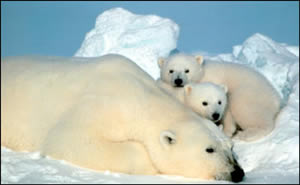 |
This polar bear adult and two cubs may look cute, but they are also the top predators of the Arctic. Polar bears are considered marine mammals even though they do not spend much of their time in the water. Polar bears spend time on sea ice to catch their prey from the waters below. (US Fish and Wildlife Service) |
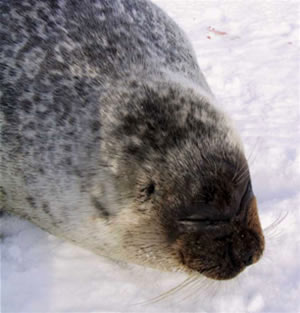 |
A sleepy ringed seal naps on the Arctic ice. Ringed seals are a species of earless seal. Ringed seals often live in the waters under the Arctic sea ice. Like all mammals, they need to breathe air. So the ringed seals surface at holes in the sea ice to breathe. Polar bears on the sea ice peer into the holes attmpting to catch a surfacing ringed seal. (B. Lee Cooper/NSF) |
 |
Northern fur seal on rocks at the shore. The northern fur seals are a species of eared seal. It lives in the Bering Sea and the Northern Pacific Ocean. (NOAA Photo Library) |






